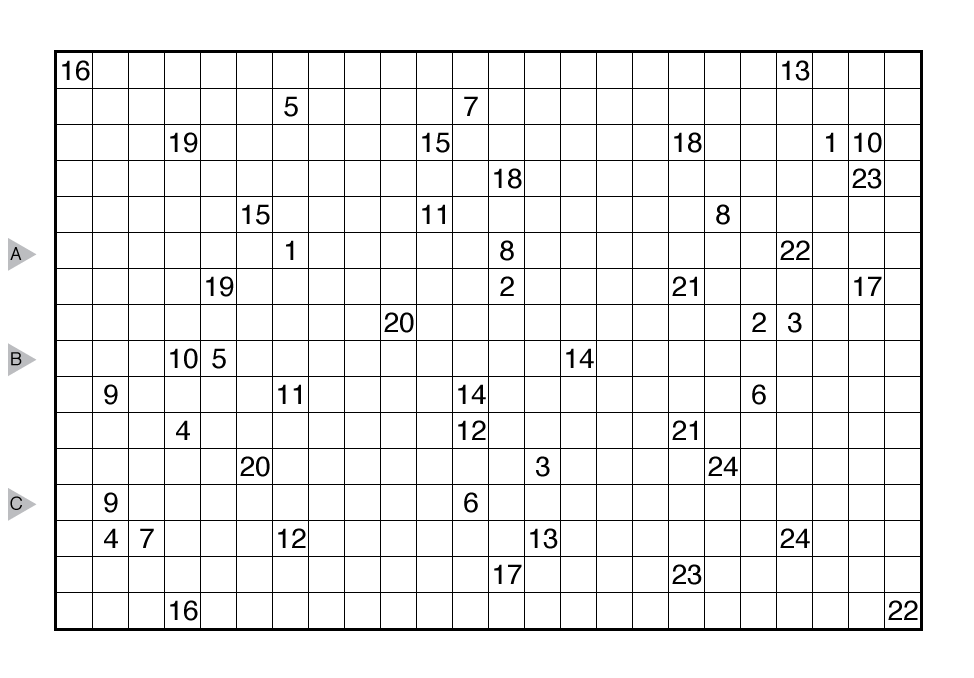Numberlink by Serkan Yürekli

(View image directly for larger form.)
or solve online (using our beta test of Penpa-Edit tools in linex mode where left click+drag draws lines and right click marks X’s)
Theme: 24 Hours Again (for patron TheSubro)
Author/Opus: This is the 128th puzzle from our contributing puzzlemaster Serkan Yürekli.
Rules: Connect each pair of identical numbers with a path passing through edge-adjacent cells. No cell may be used on more than one path.
Answer String: Enter the length in cells of the horizontal line segments from left to right in the marked rows, starting at the top. Separate each row’s entry with a comma.
Time Standards (highlight to view): Grandmaster = 2:45, Master = 5:45, Expert = 11:30
Solution: PDF
Note: Follow this link for other Loop/Path puzzles.

Great puzzle. Love the Numberlinks – and they are just not out there in any decent amount to solve. Also, the shout out on this from Serkan is greatly appreciated. Well done all around.
TheSubro
Does this puzzle require that every square is filled? Are there clear logical first steps that don’t require that assumption?
That is not an explicit rule (and in a small fraction of Numberlinks we could post there would be unused cells and still a unique solution).
The rules that require the shortest distance and that require/assume a unique solution typically (but not always) compel that every square will be used.
Great guidance on these puzzles was offered long ago by Melow Melon (Palmer Mebane)at https://mellowmelon.wordpress.com/2010/07/24/numberlink-primer/
There are a few “tricks” he left off that I typically use to start a grid. The most prominent step is to assume (based upon the shortest distance rule) that any right angle will be repeated on its interior square and again repeated … etc. This often shows where right angles cannot go, and provides in turn a logical affirmative demonstration where a third possible leg coming out of a “side” cell must go. It also helps to start blank corners on these puzzles.
Hope this is helpful.
Thanks, Ken, for the pointer to these comments from Palmer. There were a lot of useful tips in there. Plus, I can take some comfort in the fact that Palmer is willing to guess his way through a Numberlink puzzle. If he’s willing to not prove uniqueness, who am I to feel like I should?
Meanwhile, I have a hunch about Numberlink. My hypothesis is as follows:
Given a Numberlink solution, if the solution meets the following two criteria:
1. Every cell is used by a path
2. No path ever touches itself
Then the solution must be unique.
I haven’t been able to come up with a counter-example for this. Can anyone else? If not, can anyone prove the above hypothesis? I figure if we could prove this once in the general case, then we could have that much more comfort when guessing our way to a unique solution.
Easy counterexample: Consider a 4×4 grid with 1s in R1C1 and R2C3, and 2s in R3C2 and R4C4. Then the solution that fits the criteria given is easy to find (and unique if it is required for a solution to fit those criteria), but not the only solution (there are many solutions that do not fit those criteria).
However, if those two rules were added to the rules of Numberlink, such that all solutions must fit those criteria, I wonder if the hypothesis is true?
Yes. Thanks for that counterexample. I’m rather embarrassed I hadn’t come up with something like that myself.
It is interesting to note that this approach for a 2-path Numberlink can be extended to fill an arbitrarily large grid with what appears to be a unique solution, (if the above rules are added to the puzzle), with the paths spiraling around each other to fill every square and also keeping each other separate.
It also feels fairly straightforward to solve such a puzzle logically, (by filling in all the corner-derived straight lines, and at the end connecting them up in the only spiral direction that works).
One big gripe I have with Numberlinks is my complete inability to prove solution uniqueness, despite my ability to solve them without much difficulty.
OK, so, ner lbh fnlvat gung lbh hfr gur snpg gung vg unf bar havdhr fbyhgvba nf cneg bs lbhe ybtvpny fbyivat fgrcf? Guvf jbhyq nyybj lbh gb fnl guvatf yvxr, gur fdhner ng gur obggbz evtug bar qbja naq bar yrsg bs gur 4 vf abg cbffvoyl ba gur cngu pbzvat bhg bs gur 4, orpnhfr gung cngu pbhyq abg or havdhr. V ernyvmr vg pna nyfb gryy lbh zber urycshy guvatf, ohg gung frrzf yvxr bar bs gur rnfvre barf gb cbvag bhg.
21:18.Very interesting and informative puzzle !